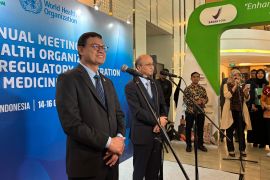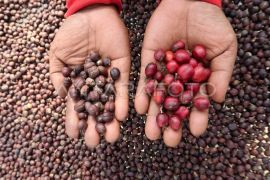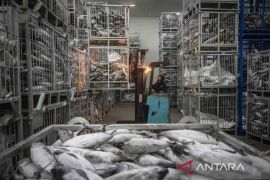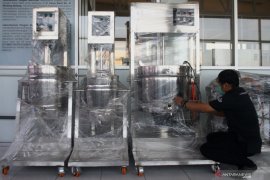"Indonesian exports in February increased when compared with exports during the previous month. Non-oil exports rose by 8.67 percent while oil and gas exports were up 0.47 percent," BPS Head Suryamin said at a press conference on Tuesday.
Suryamin said if compared with the exports during the same period last year, exports in February 2016 dropped by 8.18 percent while the total exports were recorded at US$12.17 billion.
According to Suryamin, non oil exports stood at US$10.19 billion, up 8.67 percent compared with that in January. But if compared with the US$10.42 billion figure for February 2016, the exports in February this year declined by 2.25 percent.
"The processing industry contributed 76.93 percent to the export performance, or about US$8.93 billion. This was followed by mining and other sectors which jointly contributed 11.31 percent or US$1.28 billion," he said.
The accumulative exports in the January - February 2016 period stood at US$21.78 billion, down by 14.32 percent from the same period in the previous year.
The same thing also happened with non oil exports which also declined by 9.89 percent to US$19.56 billion.
In the meantime, Indonesias imports in February 2016 were recorded at US$10.16 billion, down by 2.91 percent from the previous months figure of US$10.46 billion.
"Imports are down but in the case of oil-gas imports their volume is up," the head of the National Statistics Agency, Suryamin, said here on Tuesday.
He said the volume of imports in February 2016 was 12.76 million tons, up 14.9 percent from 11.17 million tons in January.
Domestic supply needs, such as those for infrastructure, are sufficient, he said.
Suryamin said the volume of imports rose because imports of oil and gas increased by 1.72 percent or 59.3 thousand tons while imports of non-oil and gas rose 19.75 percent or 1.5 million tons.
The hike in the oil and gas import volume was caused by an increase in the volume of import of oil products by 10.52 percent or 183,000 tons.
"Imports of crude and gas dropped by 7.97 percent and 4.06 percent, respectively," he said.
Non-oil and gas imports in February reached US$9.05 billion, down by 2.13 percent from Januarys imports recorded at US$9.24 billion. Compared to the same period last year, they were down 7.58 percent from US$9.8 billion.
The value of oil and gas imports in February 2016 reached US$1.11 billion or dropped by 8.79 percent from US$1.22 billion in January or 35.21 percent from US$1.72 billion in the same period last year.
The hike of non-oil and gas imports in February 2016 was recorded in the group of vehicles and their parts, totaling US$129.2 million or 35.35 percent, while the biggest drop was recorded in the group of machinery and mechanical equipment, reaching US$187.1 million or 10.41 percent.
Cumulatively, the value of imports from January to February 2016 reached US$20.63 billion, down by 14.48 percent from the same period last year.
Imports of oil and gas were recorded at US$2.34 billion, down 39.09 percent, while imports of non-oil and gas were at US$18.29 billion, down 9.83 percent.
China was the biggest non-oil and gas import origin country during this period, exporting up to US$4.87 billion or 26.65 percent, followed by Japan at US$1.92 billion or 10.50 percent and Thailand at US$1.48 billion or 8.11 percent.
"Non-oil and gas imports from ASEAN countries reached 22.22 percent of market share while in case of the European Union, the figure was 9.68 percent," Suryamin said.
Imports of supporting materials and capital goods during January-February 2016 were recorded 19.18 percent and 12.62 percent less, respectively, while imports of consumer goods rose by 34.38 percent.(*)
Editor: Heru Purwanto
Copyright © ANTARA 2016









